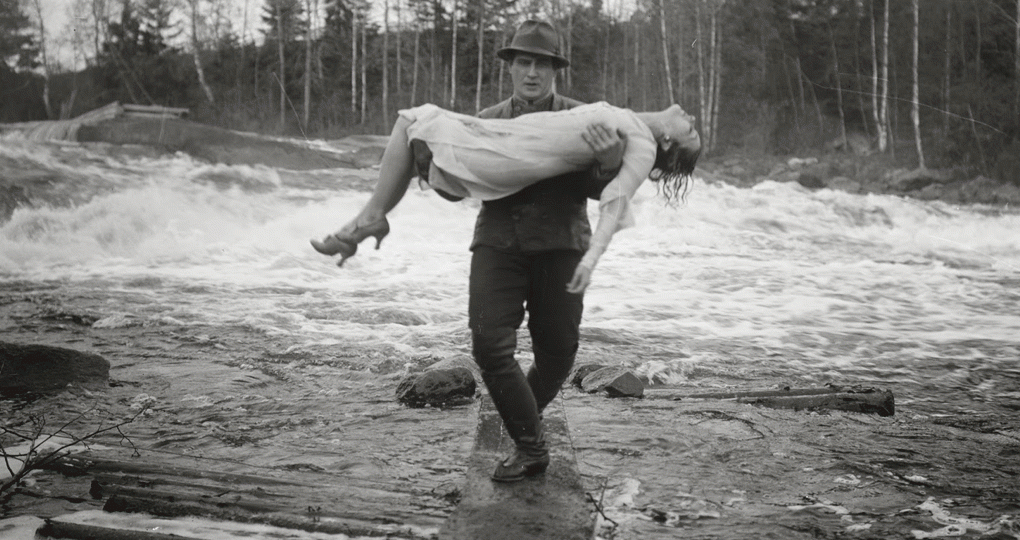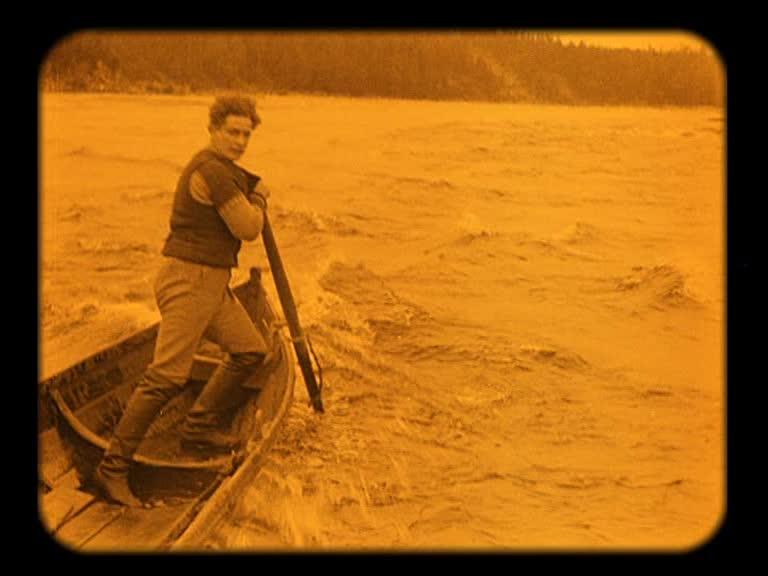
For a silent cinema historian like me, the question of body language and bodily expression has an obvious interest. Everything that sound film actors convey through the sounds of their voices, the way they read their lines, the mute actors of silent cinema had to express with their bodies and faces alone. Having learnt a great deal from cognitive film theory, I thought it would be interesting to see how and to what extent a cognitive approach might illuminate silent film acting. I have turned to cognitive theater theory, because it has been much more concerned with actors and acting than cognitive film theory.
My main example is a Swedish silent film, Johan, directed by Mauritz Stiller and released in 1921. In writings on Scandinavian and especially Swedish silent film, one of the most frequently repeated critical commonplaces is the importance of the natural landscape. It becomes, if not an equal co-actor as Louis Delluc suggested in his famous, rhapsodic review of Sjöström’s The Outlaw and His Wife (Berg-Ejvind och hans hustru, 1918), [1] then certainly something that makes the performances powerful and special. In one of the Danish reviews of Victor Sjöström’s film A Man There Was (Terje Vigen, 1917), the reviewer remarked how Sjöström’s acting “triumphed” in the film’s “mighty” landscapes: “It was as if he grew with them” (Ekstrabladet, 30 January 1917, evening edition). In his excellent book on the Swedish cinema of the “golden age” around 1920 Bo Florin noted: “As often as people talk of lyrical nature and inspirited landscapes in the films of Sjöström or the Swedish golden age more generally, as seldom has this really been anchored in analyses of how this nature is represented or wherein this ‘spirit’ consists” (Florin 1997, 81). I thought it would be interesting to see if the cognitive approach could throw more light on how and why the natural surroundings might inflect bodily expressions of emotions in 1920s Scandinavian films. Is the cognitive approach useful for this purpose? My conclusion has to be that while I do think the cognitive approach opens up some interesting and promising avenues of inquiry, some of the existing work in the field has important blind spots which I think become particularly clear when we use silent-cinema examples.
One of the most important attempts to theorize the relationship between the actor and the environment from a cognitive perspective can be found in the work of the cognitive theater historian Bruce McConachie. While his work contains many ideas I find sensible and productive, I will argue that he mischaracterizes the relationship between live drama and film. I believe, however, that it is possible to rethink his argument in a way that also throws light on the way landscape and character may interact, using Johan as my main example, supplemented by D. W. Griffith’s Way Down East(1920). In the first two sections, I will examine McConachie's key concept of the actor/character, a blend of a real person and a fictional figure, allowing spectators to engage emotionally with characters through direct simulation of the emotions displayed by actors. I find this very convincing, although I shall argue that it is important not to overstate the continuity between real-world body language and performances, all the more so since bodily expressions in films are inescapably inflected by the stylistic and narrative ways they are presented to us, as I will show in the third section through a discussion of a scene from Johan. In the last two sections, I shall look at the way actor/characters interact with their surroundings and how this affects spectators. Here, there are important differences between film and the stage, but while I would argue that McConachie overemphasizes the advantages of the stage, his focus on affordances is a good starting point for talking about the relation of actor/characters to their environments.
The Mirroring of Actor/Characters
In the books Engaging Audiences (2008) and Theatre & Mind (2013) and a series of articles, Bruce McConachie has argued forcefully that theater studies should orient itself much more in a cognitivist/evolutionary direction. He emphasizes the close connection between theater and pretend play, arguing convincingly that there is little significant difference between children who turn a small backyard into Mirkwood and theater spectators who heed the exhortation of Shakespeare’s Chorus: “Suppose within the girdle of these walls / Are now confined two mighty monarchies” (Henry V, prologue, l. 19-20). A make-believe world is effortlessly created out of thin air by having the participants assume the roles of fictional figures who inhabit it.
To explain how this is done, McConachie turns to the work of Gilles Fauconnier and Mark Turner on conceptual blending. McConachie dismisses the notion of willing suspension of disbelief. We do not subtract anything from what we see; we blend together the dramatic character - words on a page - with certain features of the actor - a living human standing before us and doing things. We may oscillate between being "immersed in the affective flow of the performance" and "considering the person on the stage simply as an actor or thinking about the character written by the playwright apart from the performer playing the role" (McConachie 2008: 46-47). McConachie frequently speaks of the “actor/character” when discussing this blended figure.
According to McConachie, the primary way spectators become immersed in the fiction is through the empathetic mirroring of the actor/characters: “When they pay attention to intentional human activity (in a performance or anywhere else), spectators unconsciously mirror the actions of social others and use this cognitive information to read their minds directly” (McConachie 2008: 79). Similarly, the leading cognitive film theorist Torben Grodal regards the spectator’s mental simulation of the bodily actions of cinematic characters as a key component of our emotional engagement with and comprehension of film. In Embodied Visions, he writes: “when we see somebody grasp a thing, we simulate, or activate, part of the grasping process; thus the neurons in our premotor cortex that are involved in planning to grasp something are activated when we witness this action performed by someone else […] our comprehension is based on a simulation of the act in our premotor cortex” (Grodal 2009: 196-97). This simulation or empathetic mirroring occurs not only with motor actions, but with sensory impressions as well: “Thus when we see a man being hit in the stomach, the same neurons that would anticipate such a blow to our own body will also reflect the other person’s experience of being hit. To understand is to simulate, even down to the level of understanding that other people grasp or are hit or touched” (Grodal 2009: 197). This leads to what Grodal calls an “immersed” film-viewing experience, involving “the simulation of action-motivating emotions seen from the perspective of the characters in the film” (Grodal 2009: 182).
For instance, Johan opens with a shot of a man standing in the stern of a small boat, steering it through the churning waters of a wide, fast-flowing river. He works the single oar energetically, his feet firmly planted despite the choppy movement of the boat.

He is one of the main characters of the film, and although we will never learn his name – he is referred to as “the stranger” throughout – we already know from our bodies’ response to seeing him stand in a small boat bobbing up and down on a wild river while working a heavy oar that he is a man of great strength and agility, fearless and strong-willed.
McConachie emphasizes that this is not an interpretation, but interactional simulation, direct and pre-linguistic:
[T]he mind does not need to generate signs or holistic images and manipulate these complex representations to understand much of what actor/characters do on stage. If the mind/brain is mirroring their intentional motor actions (and coordinating inputs from sound and sight in the process), semiotic and phenomenological mental operations become largely superfluous for gaining information about the beliefs, emotions, and intentions of actor/characters. (McConachie 2008: 79)
This is a powerful idea, and it is worth pointing out that it connects McConachie's ideas with one of the pioneering theorists of film and bodily expression, Béla Balázs. In his 1924 book Der sichtbare Mensch(“Visible Man”), he argued that the silent cinema could help us reacquire the ability to understand the minds of others through their bodily and facial expressions. This ability had been lost since the invention of printing through the growth of “word culture,” abstract and conceptual. But film can help us repair this loss; in the silent cinema, as Malcolm Turvey summarizes Balázs’ argument, “actors are forced to learn how to express themselves through their faces and bodies, thereby educating the film viewer to see the face and body as expressive of mind” (Turvey 2006: 84). This ability to see does not involve words, signs, or concepts, Balázs insists:
For the man of visual culture is not like a deaf mute who replaces words with sign language. He does not think in words whose syllables he inscribes in the air with the dots and dashes of the Morse code. His gestures do not signify concepts at all, but are the direct expression of his own non-rational self, and whatever is expressed in his face and his movements arises from a stratum of the soul that can never be brought to the light of day by words. Here, the body becomes unmediated spirit, spirit rendered visible, wordless. (Balázs 2010: 9)
We thus have a convergence of old and new theoretical ideas that make body language and bodily expression extremely significant for our engagement with dramatic fictions, on screen or on stage. The problem is that “the intentional human activity” to which spectators pay attention is assumed to be more or less the same “in a performance or anywhere else,” as the quotes from both McConachie and Grodal show. But this may overstate the continuity between real-world body language and performances.
The Ostentiveness of Performance
McConachie emphasizes the spectator’s empathetic mirroring of characters to the extent of arguing that even in the ancient Athenian tragic theater, where actors wore full-face masks, they would “compensate for the loss of their facial expressiveness through other means that encouraged empathetic mind reading” such as the use of “a wide range of vocal expressiveness that denoted the emotions of their characters” (McConachie 2008: 75). This position must probably be understood as a reaction against the overwhelming dominance of theater semiotics in the study of theatrical gesture and bodily expression, but it seems to understate the clear discontinuity between engagement with other people in real life and the actor/characters of the Athenian theater (who spoke in verse and presumably loud enough for their voices to reach all the 17,000 spectators the Theater of Dionysus could accommodate).
In his contribution to the present issue of Kosmorama, Lennard Højbjerg suggests that body language in fiction films can be divided in three categories, depending on the degree of mediation involved: some bodily expressions are similar to the ones we see in real life, whereas others are specifically fictional, exaggerating or minimizing the expression in a way we would not usually find in real life, or even caricatured to the point of never being found in real life (Højbjerg 2014 in this issue). “Real life” is of course a notoriously slippery standard of comparison, and discussions of body language in film have tended to emphasize the fictional or rhetorical aspect, often influenced by semiotics: James Naremore has pointed out that speaking of the “semiotic” function of gesture goes back to the influential French declamation and acting teacher François Delsarte (1811-1871), who used the term “well in advance of either Peirce or Saussure” (Naremore 1990: 52).
Naremore describes a distinction somewhat similar to Højbjerg’s, differentiating between “two broadly different techniques for producing expressions” in his book Acting in the Cinema:
At one extreme, the actor develops the body as an instrument, learning a kinesics, or movement vocabulary; at the other, he or she is encouraged to behave more or less normally, letting gesture or facial expression rise “naturally” out of deeply felt emotion. (Naremore 1990, 51)
The former technique is at the heart of what he calls the “pantomime” tradition, “a performance technique that relies on conventionalized poses to indicate ‘fear,’ ‘sorrow,’ ‘hope,’ ‘confusion,’ and so forth” (Naremore 1990: 51). Delsarte was a key figure of this tradition, and as a number of historians have discussed, the acting in silent films at least up to 1920 is often marked by it.
We can find clear instances of it in Johan, for instance in leading actress Jenny Hasselqvist’s repeated clasping of her forehead, a conventional gesture that signifies suffering or horror. Hasselqvist plays Marit, a foundling, and despite the title of the film, Johan is really her story. As an infant, she was taken in by Johan (Matthias Taube), a farmer with a domineering mother. Marit works as a maid until Johan's mother tries to run her off, but Johan insists that she must stay, and marries her half-way through the second reel. By this time, however, she has already met the tall, dark stranger (Urho Somersalmi), who has awakened feelings in her very different from the “safe fatherliness” of the much older and less prepossessing Johan. Right after an intertitle has concluded a scene by stating, “In this way Marit became Johan’s wife,” we see Marit looking out the window at her husband working in the snow (the winter weather indicates some months must have passed since the marriage). She sits for a long time, lost in thought.
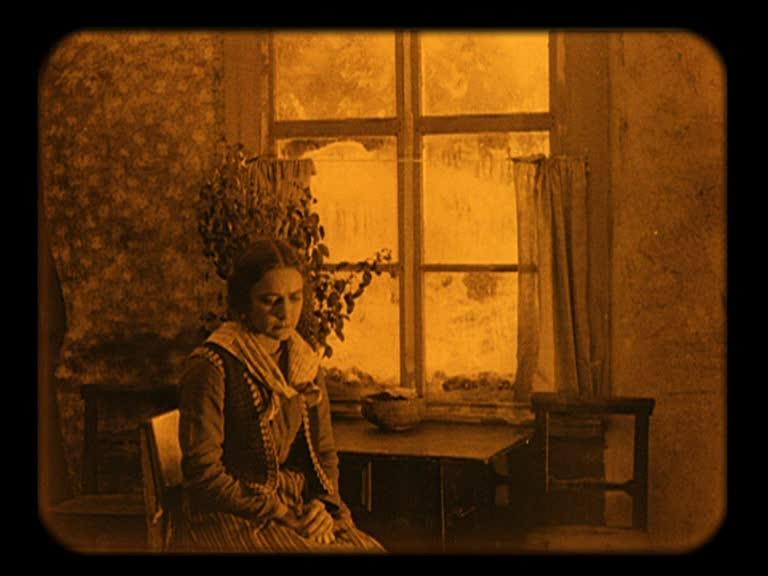
A flashback shows us what is on her mind: her thoughts are drawn to the dark stranger who came to the village a year or two before.
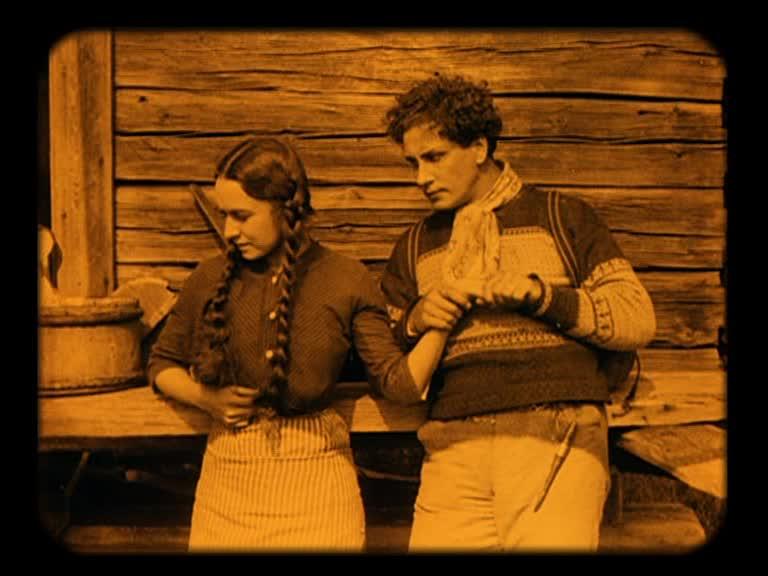
She comes out of the reminiscence with a dreamy smile,
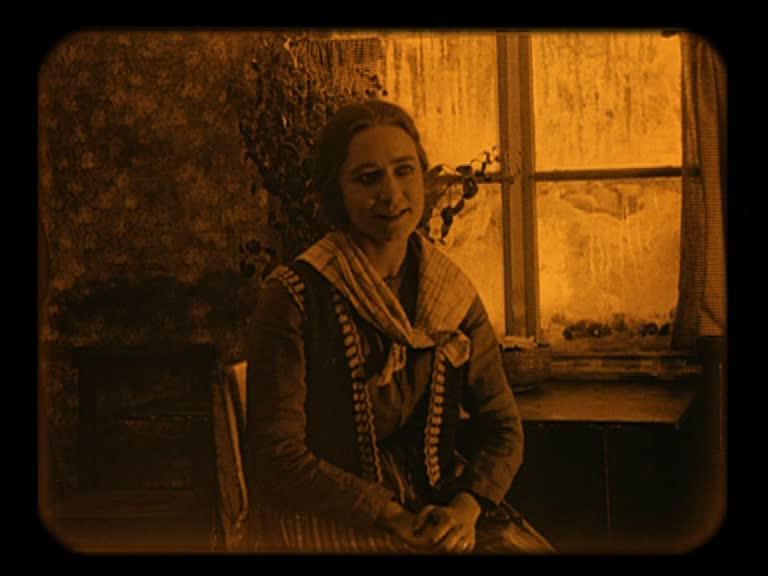
but then she clasps her forehead in dismay.
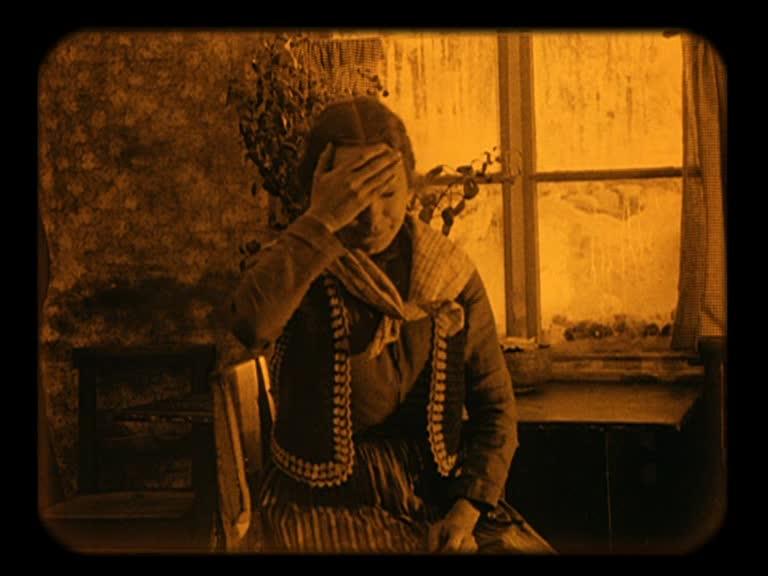
Johan now enters and approaches her. She clutches her forehead again as if to show she is unwell, but when Johan tries to touch her comfortingly, Marit recoils in horror and runs into another room, giving us several further variations of the head-clutch.
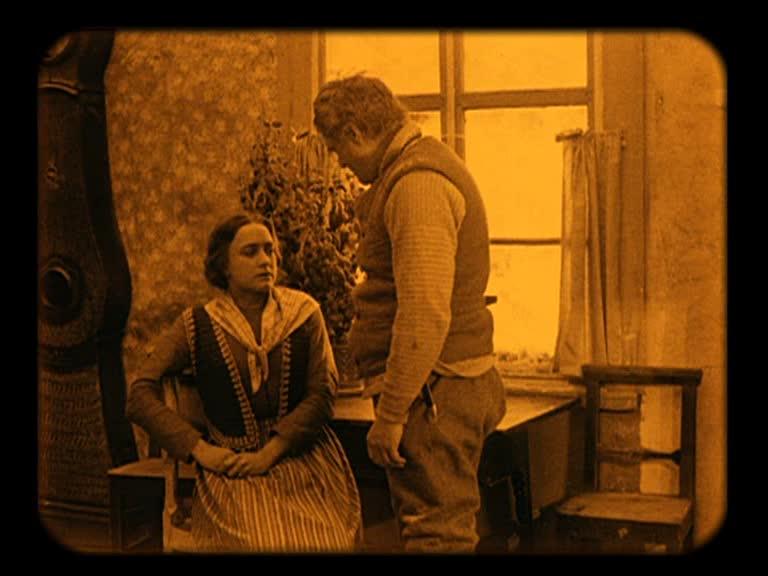
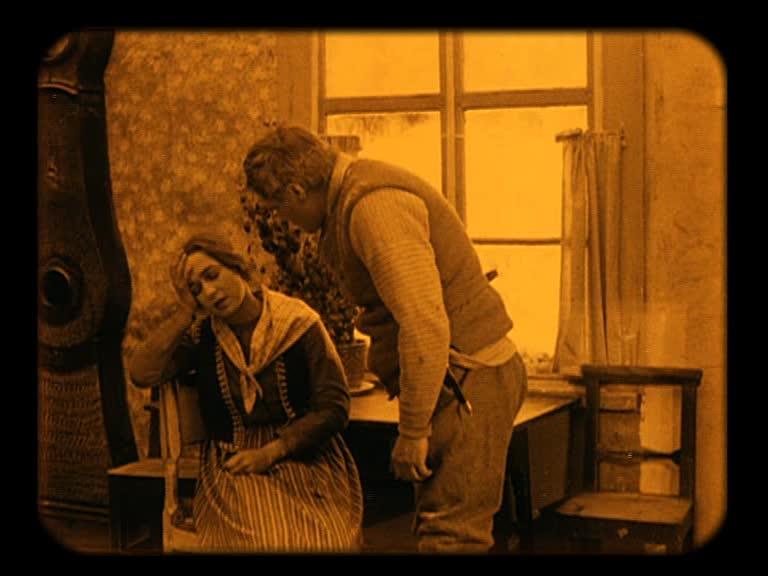
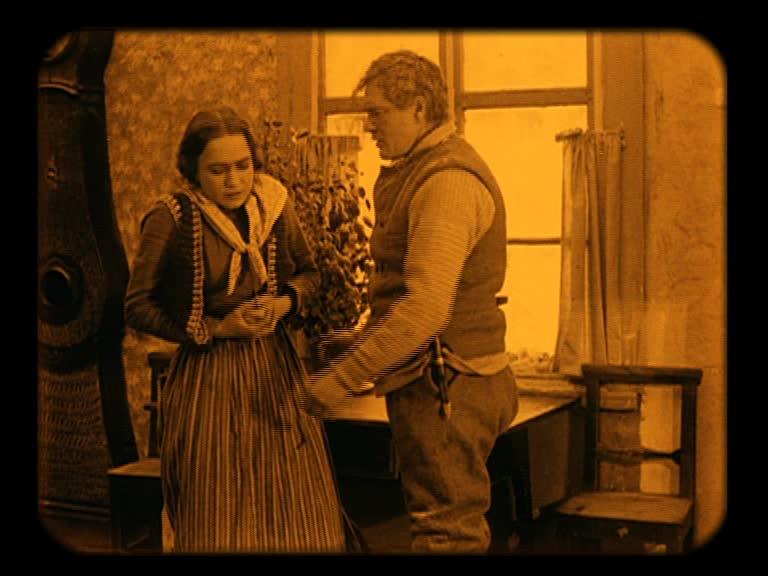
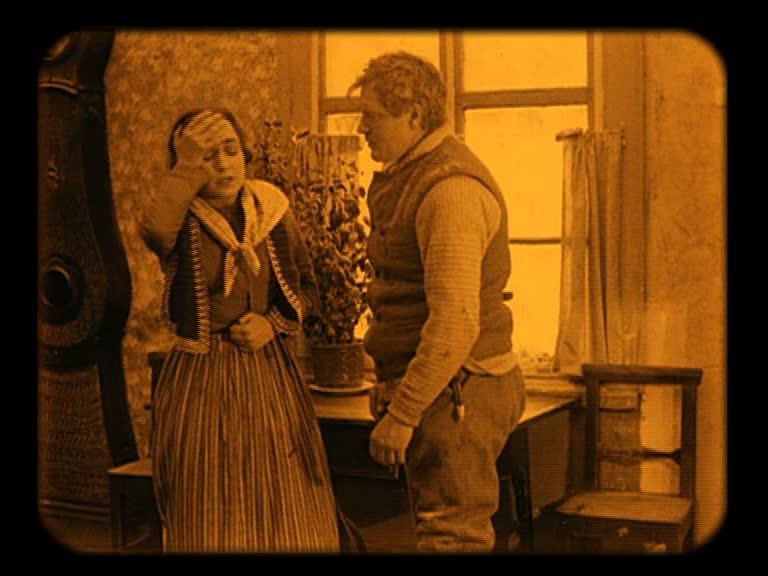
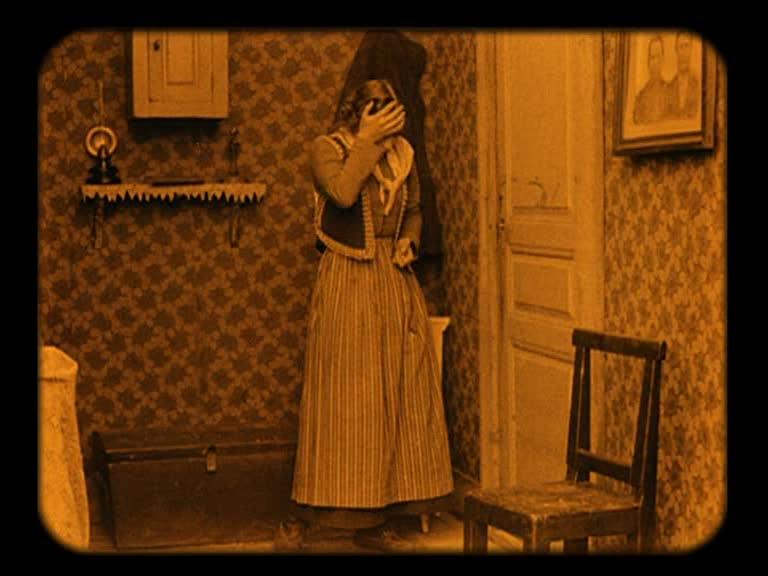
Hasselqvist was trained as a ballerina and clearly familiar with the pantomime tradition, but it should be said, though, that her performance is in many ways quite naturalistic: one may note the way her whole body stiffens convincingly when Johan touches her, but also in her ability to shift between and blend conflicting emotions, of which I shall say a bit more in the next section.
Actors working in the pantomime tradition or otherwise taking a rhetorical, presentational approach will tend to employ a body language rather different from that used in real-life situations, where “considerable latitude is allowed for insignificant lapses [and] irrelevant movement”; instead, “movements are at once less frequent and more empathic” (Naremore 1990: 35). Urho Somersalmi’s performance as the stranger is a good example. He returns in a scene that occurs a few minutes after the one we just looked at, at the beginning of the third reel.
While we have seen Johan work in the snow, the stranger only appears in the sunny summertime. This is logical enough, given that he is a seasonal worker, but it also underscores that he is very much a pleasure-loving and free-living character. Somersalmi moves deliberately, and he arranges his body in forceful poses, seeming to swagger even when standing still. The stranger’s eyes sparkle as he leers at Marit, who is milking a cow in the field and does not see him till he calls out to her. He steps over the fence with one leg, then lifts the other chest-high to clear a tall fence-post, giving the strapping Somersalmi a chance to show that he is a prime physical specimen.
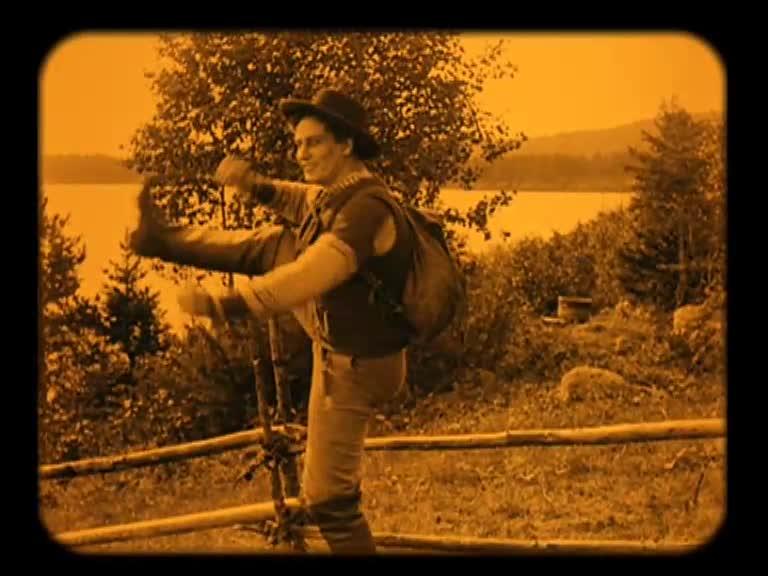
He could just as easily have taken a step to the side and lifted both legs over the much lower part of the fence he steps over with his other leg; but in this way, he moves towards Marit by the most direct route possible, making a self-satisfied shrug after crossing. Somersalmi’s performance clearly falls into Højbjerg’s exaggerated category, and that raises the question of how a cognitive approach should deal with it.
While cognitivists often emphasize the continuity between our apprehension of the real world and the way we engage with fictions, no one really takes the simplistic position that the closer a performance is to “real life,” the easier it is for the audience to mirror, and the more emotionally effective it would tend to be. Instead, there is broad agreement on Naremore’s key point: “All theatrical performance (even the naturalism of actors like Spencer Tracy and Robert Duvall) involve a degree of ostensiveness that marks it off from quotidian behavior” (Naremore 1990: 17). Nor does anyone take the equally simplistic view that the more exaggerated a performance is, the easier it is to mirror. Such a view is not unimaginable: one might take a cue from V. S. Ramachandran and W. Hirstein’s widely discussed article “The Science of Art” and its aphoristic, half-serious claim that “‘All art is caricature’” (Ramachandran and Hirstein 1999, 18), and then claim that Somersalmi’s swaggering produces a peak-shift-like effect, making it more emotionally engaging than a more restrained performance. But, as the philosopher John Hyman has convincingly shown in his devastating demolition of Ramachandran and Hirstein’s article, the peak shift effect documented by psychologists does not operate the way Ramachandran and Hirstein say it does (Hyman 2010), and the difficulty modern audiences have with performances in the pantomime tradition would seem to undercut any claims that they are necessarily more effective.
Nonetheless, empathetic mirroring, I would argue, depends less on whether actors’ gestures accurately reproduce what real-life gestures look like and more on how the performed gestures are perceived. Clearly, for a pre-conscious bodily simulation to occur, the gestures must be similar enough to real ones that spectators recognize them instinctively; but it is possible that this reaction is triggered by certain key features which may be given extra emphasis in a performance. The empathetic, distilled character of pantomimic acting may support such reactions to a certain point. Furthermore, our engagement in the characters may help us accept that actors allow their bodies to reveal much more about what goes on inside their characters than would occur in real life: the gestures may be verisimilar, but the fact that they are not suppressed is not.
The Framing of Expressions
In his book, Naremore discusses situations where theatrical conventions allow players “to reveal information to the audience without much regard to the other characters” (Naremore 1990: 75). This happens very overtly when a character is allowed to address a private remark, an “aside,” unheard by the other characters, directly to the audience, as Groucho Marx frequently does, but Naremore notes how even in highly naturalistic filmmaking, actors are allowed “to register conflicting emotions as if they were only thinking to themselves, outside anyone’s view” (Naremore 1990: 75). He goes on to describe this convention as “a fundamental trope of realist film acting: the player assumes a representational stance, her gaze turned slightly away from the lens, and then makes at least two different faces, both clearly visible to the audience, one coded as ‘suppressed,’ the other as ‘ostensive’” (Naremore 1990: 80). Henry Bacon discusses this kind of double signaling in his contribution to this issue (Bacon 2014), but we can also find an example of it in the sequence with Marit and Johan we examined before.
The key shot here is the one following that of Johan wiping the snow from his hat: Marit tries to smile at him,
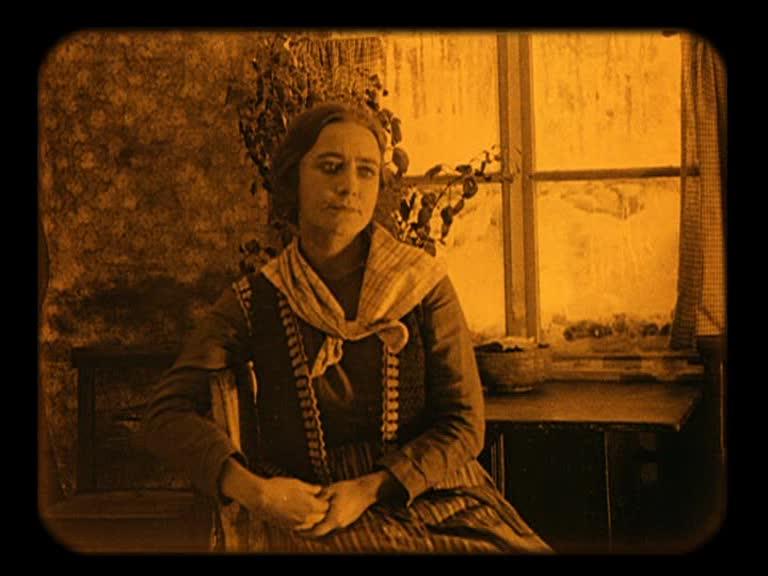
but then she looks him up and down, and her expression becomes tinged with distaste; she sighs, and her lips curl slightly.
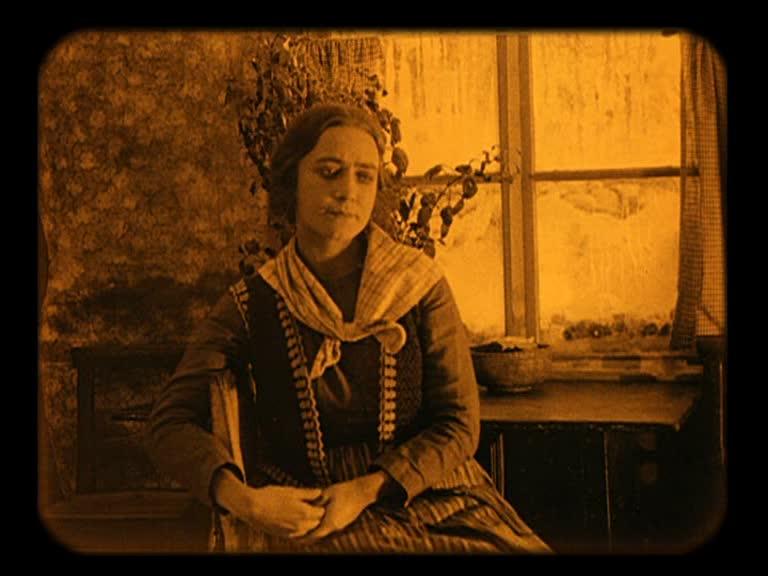
Both expressions are subtle, but only one is meant to be visible to the other character: the vague smile is visible to Johan, but the suggestion of distaste is meant only for us. By noting how even highly naturalistic actors engage in this kind of surreptitious communication with the audience, Naremore seeks to emphasize that even transparent-seeming body language may often be specifically fictional – or at least its invisibility to the other characters is.
It is also worth pointing out how Stiller helps make it believable that Johan does not see some of Marit’s emotions by varying the shot scale: the emotions that only we are meant to see occur in the closer shot of Marit, whereas the reactions we see in the wider shot are also apparent to Johan. As Lennard Højbjerg emphasizes, when we watch a fiction film, we are presented with “a synthesis of narrative strategy, style and bodily expressions” (Højbjerg 2014 in this issue; italics added). The body language does not stand alone, and this is another reason we should be careful not to elide the difference between watching a performance and watching a real-world act.
The tableau-style cinema of the 1910s makes the interplay of body language and cinematic staging particularly apparent. Because of its reliance on long, continuous shots, it has often been thought of as “theatrical.” But as David Bordwell has shown, the filmmakers of this period were very aware that the playing space of a film was profoundly different from that of the stage (Bordwell 1997: 182-83). On the stage, the mise-en-scène has to take into account that the action must be legible for spectators sitting in many different places in the auditorium. In the cinema, on the other hand, every spectator’s sightline on the action is the same – it is that of the camera. If a stage actor steps in front of another, most spectators will still be able to see the actor standing behind the other. But if a film actor steps between another actor and the camera, the second actor will be more or less completely hidden from view. In a film, blocking can therefore be used to direct the attention of the spectator in a much more precise manner than on the stage.
If we go back to the sequence from Johan where the stranger returns, which we discussed above, we saw that the stranger may seem a very stereotypical figure – the broad-shouldered, amoral, studly skirt-chaser – but the character is given an extra dimension by the landscape. He is consistently linked with the water; as we saw, the very first shot of the film shows him standing in a narrow skiff, navigating down a fast-flowing river. This gives his character a power, a grandeur, a looseness and liberality that he would not otherwise have had. In the sequence of his return, he is shown against a background of water, a broad river flowing by, in every shot in which he appears.
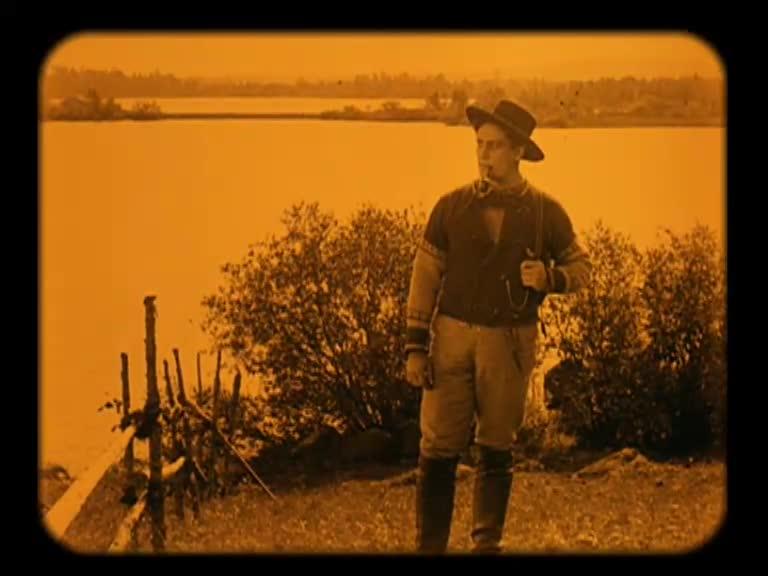
In this sequence, Stiller orchestrates the interplay of looks with consummate skill. After the first shot of the stranger, we see him from a camera position close to where we assume Marit is sitting. This sets up a shot/reverse-shot structure, priming us to expect her to look back at him. She eventually will, but Stiller keeps the suspense going for several more shots before she finally looks up and sees him. Differences in shot scale reflect the differences in the two’s awareness of the situation. Marit, in a more distant shot, is oblivious to the stranger’s presence, while he, seen in a closer view, seems already to be planning her seduction.
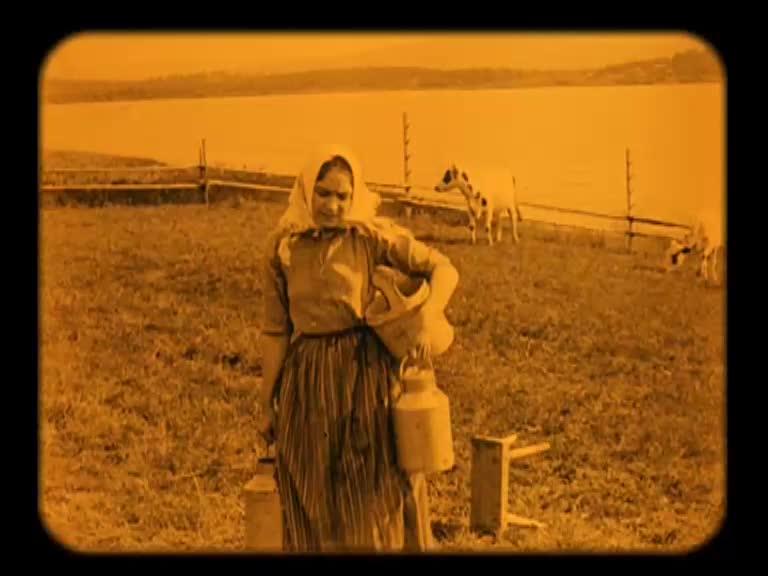
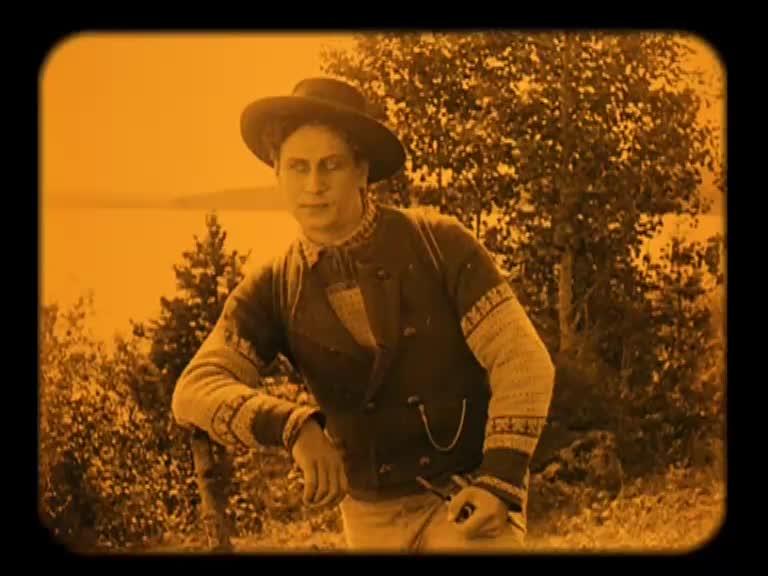
When he speaks to her, we cut to a medium shot of Marit, now seen almost directly from the front, looking at the stranger slightly to the right of the camera. A conflict of emotions plays out on her face, brilliantly performed by Jenny Hasselqvist.
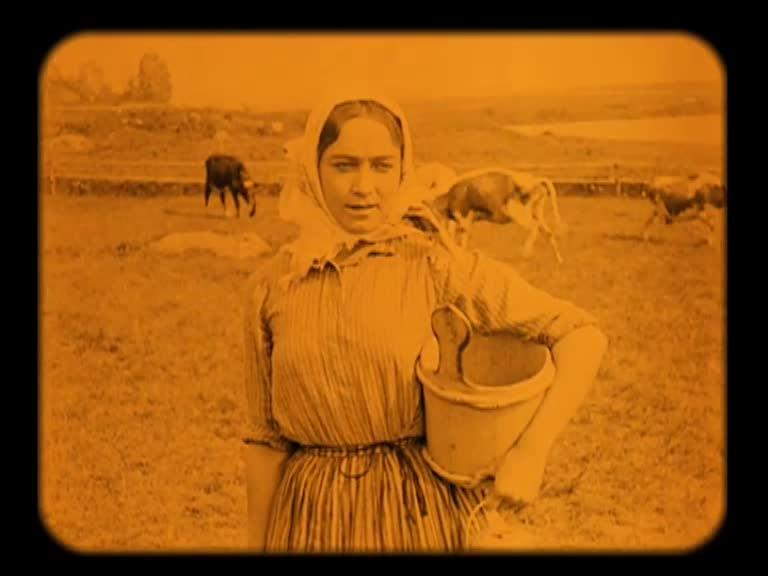
She is happy to see the stranger again, but also fearful; she is unsure of what to do. Up to this point, Marit has been photographed from a more oblique angle than the stranger; we get to look him more fully in the face than Marit. But this shot gives us an even clearer view of her, reminding us that her emotions are central.
After he has crossed the fence, we cut to a medium long shot of Marit, framed to include considerably more water in the background than the previous shots. She stands to the left of the middle of the frame, leaving room for the stranger to stride into the picture and clasp his hands together in satisfaction.
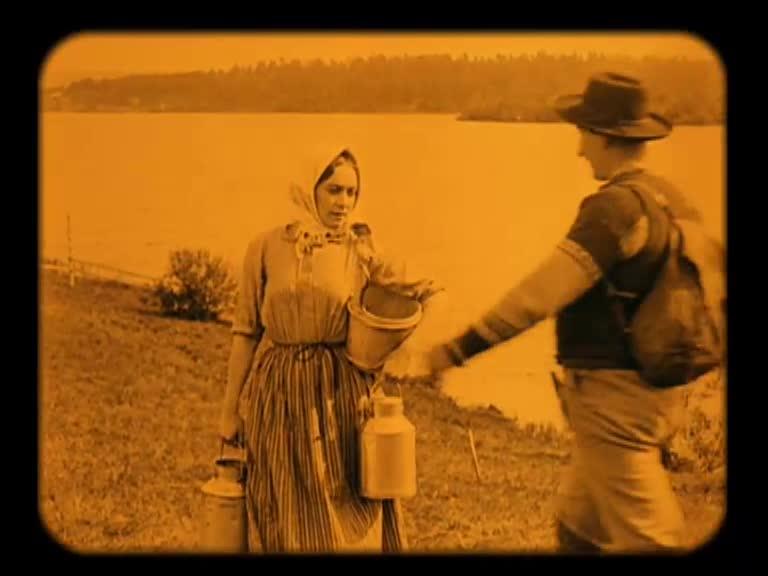
The camera pans slightly to the right, allowing the stranger to take over more of the frame as he puts his hands on his hips and leans cockily backwards. She asks him a question, and he grandly waves out towards the wide world, as if to say, “I have been travelling all over the place.” He then thrusts out his other hand for her to shake, even though he must be able to see that she has her hands full, and she has to awkwardly set down a milk-can on the ground to shake his hand.
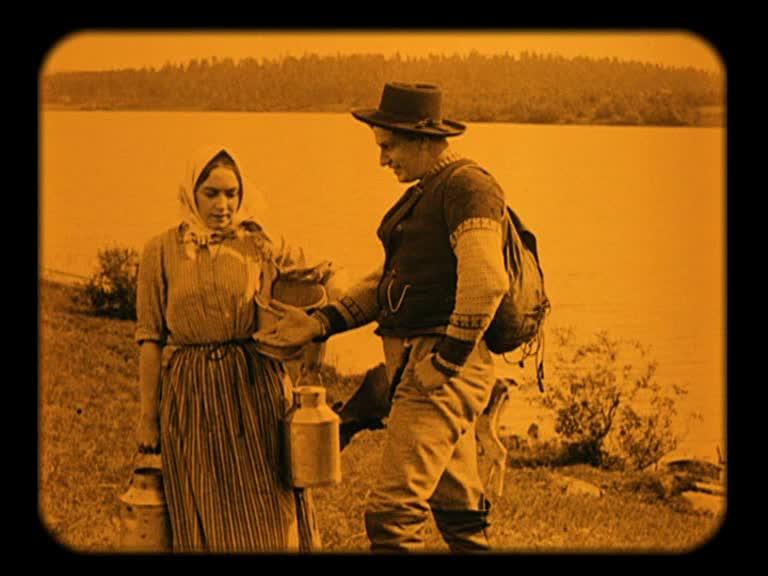
He shakes her hand with jaunty exaggeration, up and down and side to side, the way an overeager boy might do, clearly jesting but also reflecting his domineering nature.
Throughout the sequence, the changes in composition, shot scale, and camera angle reflect the emotional dynamics of the sequence perfectly. Also, as noted, the way the characters are placed in relation to the background also seems significant. There is much more water visible in the shots of the stranger, and in the two-shot, the shoreline behind them is angled sharply downwards, so while the land takes up about half the height of the frame on Marit’s side of the frame, the water takes up more than three-quarters of the background on the stranger’s side.
Højbjerg, as we have seen, speaks of a “synthesis,” and in fact we find the same idea formulated by Béla Balázs in his second book, Der Geist des Films (“The Spirit of Film”) from 1930:
But there is no such thing as physiognomy “in itself”. There are only the physiognomies that we see. And these change according to the angle from which we view them. Physiognomy depends on point of view, in other words, on the camera set-up. Physiognomy is not only an objective given, it is also our relation to it. A synthesis. (Balázs 2010: 112)
While Balázs is particularly interested in the close-up of the human face and the nuances it reveals, he uses the term “physiognomy” in a broader sense, as the editor’s notes to the 2010 translation of Visible Man and The Spirit of Film point out. Balázs uses the word “to refer to what he also calls the ‘face of things’, the entirety of the visual world that is contained within the film image” (Balázs 2010: xii-xiii). I will return briefly to the idea of a “physiognomy of landscape” at the end of the paper, but my main focus will be the affordances the landscape provides for the actor/characters and how that affects their body language.
Visible Intentionality
A few weeks before the premiere of Victor Sjöström’s The Outlaw and His Wife on New Year’s Day 1918, Jóhann Sigurjónsson, the Icelandic author of the play on which the film was based, was interviewed by the Danish newspaperwoman Charlotte Haslund. Sigurjónsson had just seen the film – Sjöström arranged an advance screening in Copenhagen where he lived – and while he had mixed feelings about the adaptation leaving out much of his poetic dialogue, he was enthusiastic about the artistic potential of the new medium of film, not least its ability to stage its stories in real locations: “Imagine what it means that instead of man-made, painted stage flats, you can move nature itself into the presentation; you can achieve the most perfect harmony between the inner subject matter and the natural surroundings,” Sigurjónsson said (Haslund 1917).
Yet McConachie would argue that this idea is mistaken. “Evolution,” he argues, “trained our species to learn to read the emotions and intentions of other people in live, three-dimensional environments.” The theater, he argues, offers such a live, three-dimensional environment; the screen does not. Space in films is “fungible” and can be manipulated, while at a play, spectators “always know the ‘affordances’ the actors are working within” (McConachie 2011: 144). “Affordance” is an important term in the lexicon of cognitive theory; introduced by the psychologist James J. Gibson, it refers to the “action possibilities” an object or environment presents. The “empathetic response” of theater spectators to “the whole-body movements of the actors’ muscles in that stage environment” (McConachie 2011, 143-44) is therefore much stronger, according to McConachie, that that of film spectators, since film offers much less scope for such empathetic mirroring than the stage: “Spectator empathy with filmed actors/characters in an environment is never totally eliminated, of course, especially for those films that are shot on location. But it is usually diminished” (McConachie 2011: 144).
McConaghie wants to suggest that there is a categorical difference between live performance and recorded movies, and that it rests upon "good cognitive science" (McConachie 2010: 29), referring specifically to neuroscientific research into human action perception involving mirror neurons or the mirror mechanism identified by the Italian scientists Giacomo Rizzolatti, Vittorio Gallese, and their colleagues. They argue that the mirror system in human brains is exquisitely sensitive to intentionality, activating in different ways when we see someone picking up a coffee cup to drink from it and when we see someone picking it up to clear it from the table (Iacoboni et al. 2005).
The issue of intentionality is key to McConachie’s argument for a categorical difference between film and live theater. He supports this with arguments drawn from the work of philosopher Noël Carroll, who is generally sympathetic to the cognitive approach.
In his 2006 article "Philosophy and Drama: Performance, Interpretation, and Intentionality," Carroll argues that the "art of drama as performance, though perceptually very much akin, in many respects, to the mass fictions projected by the movies, is nevertheless radically, categorically different" (Carroll 2006: 119). Carroll argues that while the intentionality of live performers can take into account and respond to the audience present before them, using all the resources of their art, there is no art involved in showing a movie, and the only intentionality is that of the person pushing the play button.
On one level, this is obviously true - a performance and a moving image of that performance are not the same thing. The question is: how significant is it? Carroll appears to attach considerable significance to it. He writes that drama is what he called a two-tiered art form where the artistry may be found both at the level of the "composition" or "performance plan" and at the level of the performance. One might think that this applies to movies as well: first, a screenplay is written; then, the film is shot. But Carroll denies this: he claims that a film, a "mass-mediatized artwork is not a two-tiered art form, but single-tiered, more like a novel than a performance" (Carroll 2006: 117). This is because, at the point of contact with the spectator, there is just a machine cranking along: "Once the motion picture has been edited and put in the can for good, there is no opportunity left for intentionality" (Carroll 2006: 116).
McConachie embraced this argument in his 2008 book and connected it with the research on mirror neurons, claiming that since the movies have no real intentionality, they do not activate our mirror mechanisms and do not produce the empathetic mirroring stage performers do. This seems obviously absurd and certainly is not what Carroll was getting at. Carroll has been notably circumspect in his discussion of mirror neurons (Carroll 2011: 177-80; Carroll and Moore 2009: 424-25; 2011: 340), and he quite clearly allows that we as spectators respond empathetically to the movements and expression of film performers: "When Hamlet's muscles bunch up - on either stage or screen - we feel a tug in our own" (Carroll 2011: 178).
In two later articles, McConachie writes that he has “changed his mind” (McConachie 2010: 43 n9; 2011: 146 n5) about the claim that we do not mirror the intentional actions of film performers – a claim he ascribes to Carroll – but instead refers to “hyperactive agency detection devices” (HADD for short), mental mechanisms presumed to exist by cognitive scientists of religion. For evolutionary reasons, humans are prone to see intention behind many random occurrences – those who worry about tigers every time the leaves rattle may survive longer than those who say that it’s just the wind, even though the latter are right more often. This presumably leads us to invent wrathful thunder deities to explain lightning strikes – and also to ascribe intentions to film characters who do not have them. McConachie quotes Justin Barrett as saying that HADD not only makes us believe in gods and ghosts, “but also ‘makes us non-reflectively believe … that light patterns on a television screen are people or animals with beliefs and desires’” (McConachie 2011: 139; quoting Barrett 2007: 189). McConachie continues:
The cognitive operation is the same for film as for TV: because viewers see a phenomenon that appears to possess some independent agency and looks to be human, they project their notion of human intentionality onto it. In short, HADD made it easy for viewers to believe in the sights, and later the sounds, of early twentieth-century performers on film. (McConachie 2011: 139)
While McConachie may have changed his mind about some aspects of his theoretical account, the intentions and bodily expressions of film actors remain entirely unreal. The account is not tenable, however.
It is worth noting that the psychological experiments involving the mirror system usually employ moving images as stimuli rather than live performances. In the coffee cup experiment, for instance, test subjects saw the reaching and grasping actions in what the article calls either "movie clips" or "video clips." When Vittorio Gallese came to Copenhagen in 2012, I asked him whether live and recorded intentional actions were the same from a neuroscientific point of view. He said that it had to be recognized that experimental psychology relied overwhelmingly on stimuli that were “fictional.” The work of Riitta Hari, however, suggested that actions seen on video activated the same mechanisms as the same actions seen live, but less strongly (Jarvelainen et al. 2001). Gallese's "gut feeling" was that the difference was "dimensional", a difference of degree, rather than "categorical" (personal communication, 30 May 2012). Arguably, he punted on the question, but it is still clear that brain science does not support a categorical distinction between live and mediated performances.
There is no reason to think that film relies any less on empathetic mirroring than the theater; if anything, the opposite is the case. Hugo Münsterberg, who anticipated a great deal of cognitive film theory with his 1916 book The Photoplay: A Psychological Study, writes: “More than in the drama, the persons in the photoplay are to us, first of all, subjects of emotional experiences” (Münsterberg 2002: 99). We imitate the emotions we see expressed, Münsterberg writes, an imitation which “brings vividness and affective tone into our grasping of the play's action” (Münsterberg 2002: 104). He goes on to describe how these emotions are felt bodily by spectators:
We sympathize with the sufferer and that means that the pain which he expresses becomes our own pain. We share the joy of the happy lover and the grief of the despondent mourner, we feel the indignation of the betrayed wife and the fear of the man in danger. The visual perception of the various forms of expression of these emotions fuses in our mind with the conscious awareness of the emotion expressed; we feel as if we were directly seeing and observing the emotion itself. Moreover, the idea awakens in us the appropriate reactions. The horror which we see makes us really shrink, the happiness which we witness makes us relax, the pain which we observe brings contractions in our muscles, and all the resulting sensations from muscles, joints, tendons, from skin and viscera, from blood circulation and breathing, give the color of living experience to the emotional reflection in our mind. (Münsterberg 2002: 104-105)
Some modern cognitive film scholars would even argue that film allows for much greater immersion than the stage drama because we can see the actor/characters much better. Torben Grodal does not regard the theater as an immersive experience at all: “Although the spectators may mentally identify with the protagonist, they view the representation from a third-person perspective (both because they sit at a physical distance from the stage, and because actors are seen phenomenologically from the outside)” (Grodal 2009: 168). This may be taking the matter a bit far. I would suggest that both film and theater spectators watch and – through embodied simulation of bodily expressions – understand human intentionality and action, in one case before their eyes in the present, in the other case relayed from the past through technology.
The Affordances of Landscape
I do think that there is an important difference between film and theater that has to do with intentionality, but that it lies on the actor-side of the actor/character blend. This brings us back to the link between theater and pretend play: both require a shared intent on part of all the participants to go along with the make-believe, and this shared intentionality is continuously maintained by the participants. As James Naremore writes:
Even in the most pictorial proscenium drama […] the audience remains present to the actor, sending out vibrations or signs that influence the intensity, pace, and content of a given performance. Live theater is always what Brecht described as ‘provisional,’ because it depends on an immediate interaction between two specific groups […] At the movies, on the other hand, the existential bond between audience and performer is broken. The physical arrangement is permanently closed, and it cannot be opened even if the performer speaks to us directly or if we make catcalls back at the show. (Naremore 1990: 29)
This, I think, is also what Noël Carroll was getting at with his claim that film is not a performance art and that there is no intentionality at a film show. There certainly isn’t the kind of shared intentionality the continuous feedback process between performers and spectators at a live show allows for. Because the performers are there with the audience, they can continue to solicit their acceptance of the pretense that an empty stage is a wide sea or a beautiful mountain meadow, or that five actors are the English army triumphing at Agincourt. Film performers cannot do this in the same way; because they are not there, it is much more difficult for them to get the audience to play along with them.
This ties film actor/characters more closely to the fictional world. McConachie writes: "Where spectators at a film may temporarily forget the affordances for movement allowed to actors/characters, audiences in a theatre never do" (McConachie 2011: 144). This is true as far as it goes; the theater spectator is present in the same room as the actors, their physical presence inescapable. It can be endlessly thrilling to see how stage actors use the resources they have to conjure up imaginary worlds and to watch them exert themselves right in front of you. In part, this is probably because the affordances in the theater are affordances for spectators too – only norms of good behavior prevent them from climbing onto the stage and handling the props. But the affordances the stage offers to the characters are only make-believe ones. On the stage, there are no rugged uplands for Berg-Ejvind to cross, no wild rivers to ride. The virtual world of the movie, on the other hand, provides spectators with no affordances of their own, but only those vicariously available through the characters. Yet this may mean that movies make the vicarious experiences they provide much more intense, because they are more real for the actor/characters we immerse ourselves in.
A familiar example, which also parallels the bravura scene of Johan, a boat-ride through wild river rapids, is provided by the famous ice-floe sequence in D. W. Griffith’s Way Down East (1920). The 2008 DVD edition of this film from Kino International (and the 2011 Kino Blu-Ray) includes an excerpt from Edwin S. Porter’s film of Uncle Tom’s Cabin (Edison, 1903), the famous scene where the fugitive Eliza escapes from the slave-chasers by crossing a river, jumping from ice-floe to ice-floe. The inclusion of this excerpt invites a comparison of the two ice-floe scenes, as the DVD producer makes clear in his onscreen notes: Griffith’s “inspiration was […] Uncle Tom’s Cabin” (Wood 2008) – not necessarily the 1903 film, but the many elaborate stage productions of the story Griffith undoubtedly knew well. The 1903 film, interestingly, uses performers and scenery from a touring theatrical company (Mayer 2009: 42), and it therefore tells us something about theatrical staging practices of the time.
In the 1903 Uncle Tom film, the stage is separated into a front area and a middle area by flats showing a tree and icy rocks. To the rear, a moving band of cloth shows the icy river, and on the backcloth we see the far shore. Eliza and her pursuers cross the stage from the right side of the screen to the left, and then reappear behind the flats from the left, moving towards the right. Even though the two areas are right behind each other and an actor could easily step over the painted rocks to get from one to the other, the audience is meant to regard them as being at some distance from each other – leaving the slave-catcher to gesture ineffectively as Eliza floats away, even though the actor could reach the actress by taking a single step towards the rear of the stage.
Way Down East was based on a stage melodrama, but no version of it contains a dramatic ice-floe-jumping scene. In an early stage version, there is a scene where the heroine staggers through the snow beside a frozen lake, but the dramatic climax of the play was a fistfight between the hero and the villain (Mayer 2009: 212, 214-15). By adding the ice-floe sequence, Griffith not just devised one of his most gripping last-minute rescues, he also accentuated the emotional arc of the heroine and hero of the drama: “Their journeys, as the ice-floes head toward the lethal waterfall, recapitulate the plot: an accelerating race to near disaster averted by a timely rescue” (Mayer 2009: 215).
Back in 1926, the Russian director Vsevolod Pudovkin made a similar point, stressing the way the emotions of the heroine and the natural environment interact and support each other:
First the snowstorm, then the foaming, swirling river in thaw, packed with ice blocks that rage yet wilder than the storm, and finally the mighty waterfall, conveying the impression of death itself. In this sequence of events is repeated, on a large scale as it were, the same line of the increasing despair – despair striving to make an end, for death, that has irresistibly gripped the chief character. This harmony – the storm in the human heart and the storm in the frenzy of nature – is one of the most powerful achievements of the American genius. (Pudovkin 1970, 129)
The empathetic mirroring we experience when we see Richard Barthelmess desperately leaping onto real, fast-moving ice floes and Lillian Gish lying outstretched, her hand and hair dangling into the icy torrent, strikes me as being more intense and immersive as well as more directly tied to affordances for movement than that which we may imagine getting from the live performance of the Tom show seen in Porter’s film.
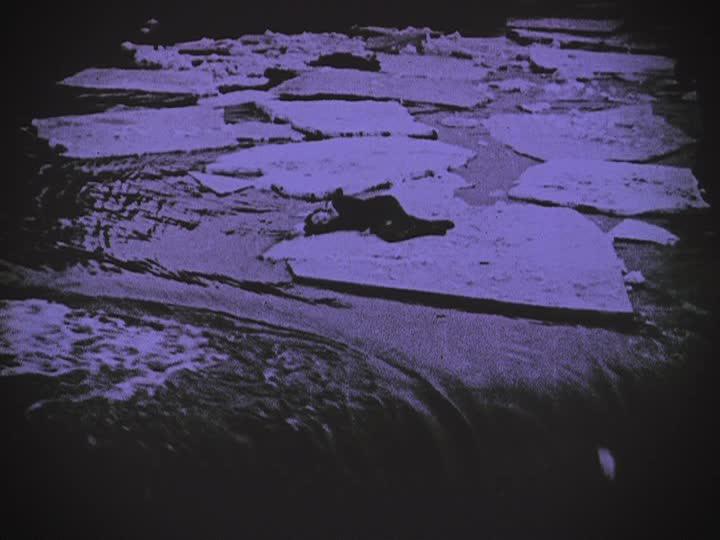
The sequence of the rapids in Johan is comparable to Griffith’s icy rescue in its virtuosity, thrill, and ability to bring together emotion and environment. (Stiller is unlikely to have seen Griffith’s film before making his own; Johan was shot in the summer of 1921, and Way Down East only had its Swedish premiere on 16 January 1922). When Johan came out, international audiences expected Swedish films, at least those set in the great outdoors, to feature a dramatic stunt sequence where the hero struggles directly against hostile nature. Johan is no exception, although here, unusually, it is the heroine who must face the challenge. At this point in the story, Marit has run away from Johan’s farm, completely fed up with her shrewish mother-in-law. On the river, she sees the stranger with his boat and allows him to take her on board. They sail away and soon enter violent rapids. Even though she doesn't have to sail the boat through the rapids, just stay inside, not panic and go overboard, this in itself turns out to be difficult and demanding. The stranger, who navigates the boat, has been consistently linked with water, with the wild river, and it is not difficult to see a metaphorical dimension in the boat-ride. There is something evidently erotic in this trip through the rapids with the dark stranger, something both exhilarating and dangerous.
The danger is not just a metaphor, of course; it is concrete and real. Jenny Hasselqvist does manage to clutch her forehead in terror a few times, but most of the time she is just hanging on for dear life.
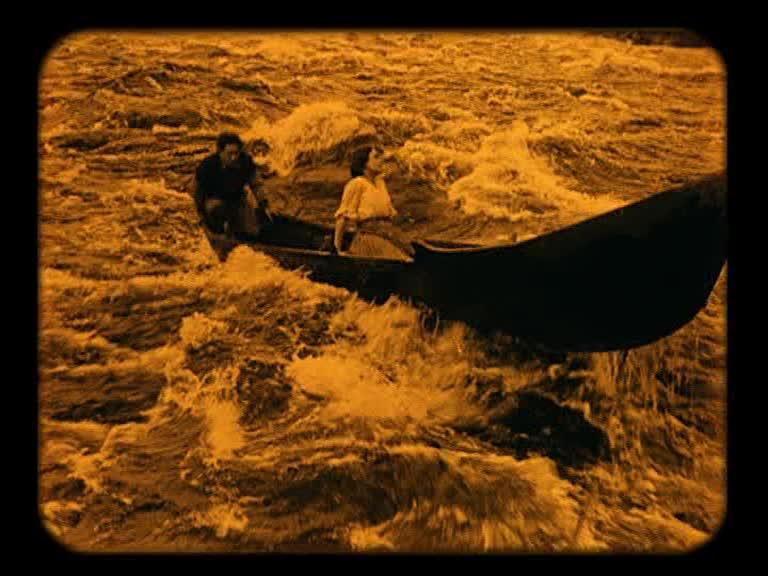
The actors were exposed very directly to the elements to make this sequence, and, one would imagine, quite a bit of actual danger. As spectators, we may simulate the experience of the wild river ride, and this probably involves, at least in part, mirroring the exertion, the tension, and the fear that the actors' bodies display. But we also become immersed in the characters’ experience in a direct way the stage could not provide us with. When actors are placed in environments that afford danger to life and limb and demand intense physical exertion to escape this danger, this will usually be reflected by spectators experiencing strong empathetic and embodied responses.
Of course, we are still dealing with simulations, if not as complete as those contemporary ones where actors move within entirely artificial environments (Alfonso Cuarón’s Gravity (US, 2013) provides a striking example). Some of the inserts where Marit is seen in closer views have evidently been shot in calmer waters,
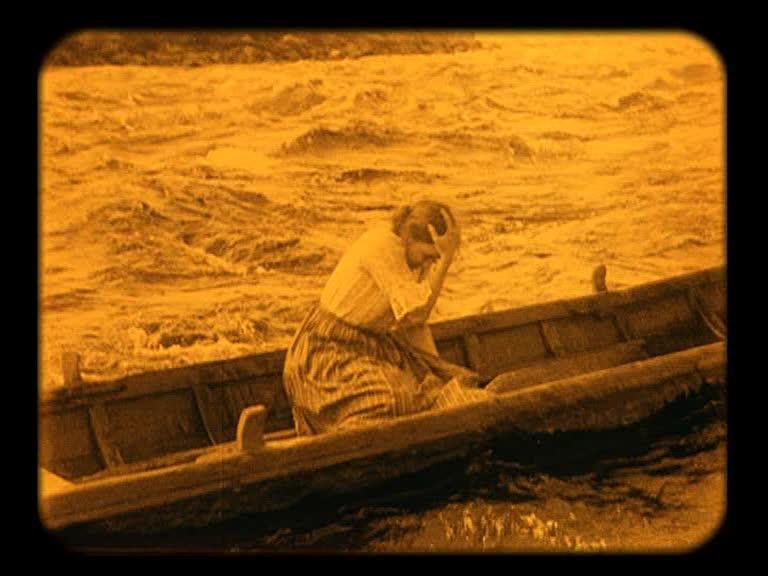
and the long shots of the boat going through the rapids may be using stunt performers. Similarly, Griffith uses his skill at editing and camera placement to suggest a more desperate peril than that to which he exposed his actors. Historically, directors have often chosen to place performers in real or realistic environments giving rise to bodily exertions and responses (sometimes involuntary or only partly conscious) through which the emotional resonances of the situation are conveyed to the spectators. This is evident when we clutch the arm-rests of our seats when Marit’s boat plunges down the rapids or when Richard Barthelmess claws desperately at the ice to pull himself out of the freezing water – but there is more to it than that.
In his analysis of the use of landscape in Sjöström’s The Outlaw and his Wife, Bo Florin tries to give more substance to traditional claims about its importance. He focuses on the “increasingly precarious position of the human being in the face of an overwhelmingly powerful nature” (Florin 1997: 84) – how, over the course of the movie, the landscape appears more and more forbidding and the characters less and less able to act within it. In the terms of cognitive theory, it affords fewer opportunities for action.
At the same time, the images of the landscape have an emotional valence of their own which is not tied to the affordances for action it presents (or fails to present) to the characters and – vicariously – to us. It is produced instead by shapes and shades, by the quality of the cinematography, by the play of the light. Münsterberg was mindful of this difference:
On the one side we have those emotions in which the feelings of the persons in the play are transmitted to our own soul. On the other side, we find those feelings with which we respond to the scenes in the play, feelings which may be entirely different, perhaps exactly opposite to those which the figures in the play express. (Münsterberg 2002: 104)
Münsterberg acknowledged that the first group was “by far the larger one,” but also suggested that the new medium of film’s potential to create emotional effects through formal and stylistic means “has hardly been touched as yet” (Münsterberg 2002: 104, 106). He continues: “As soon as we give any interest to this formal aspect of the presentation, we must recognize that the photoplaywright has here possibilities to which nothing corresponds in the world of the stage” (Münsterberg 2002: 107).
Antti Alanen has eloquently described the magical beauty of Johan, shot in Lapland in the far north of Sweden under the midnight sun: “The composition is based on the elements of light and the stream. The characters radiate in the enchanted light, and night never falls. The ever-present stream rushes forth as an image of the stream of life and even of time itself” (Alanen 2001: 67).
Clearly, what Balázs might have called “the physiognomy of the landscape” awaits further investigation. Here, I have tried to show how the environment can affect the body language of the actors and – through it and them – our experience of the story. I think our investigation here bears out Sigurjónsson’s claim about the cinema’s ability to achieve a “perfect harmony” between inner emotional experience and landscape.
BY: CASPER TYBJERG / ASSOCIATE PROFESSOR / DEPARTMENT OF MEDIA, COGNITION AND COMMUNICATION / UNIVERSITY OF COPENHAGEN
Notes
1. Georges Sadoul quotes Delluc as having written in 1921: ”Voici sans doute le plus beau film du monde. Victor Sjöström l’a réalisé avec une ampleur qui dépasse tout commentaire. Il s’y est montré un acteur magistral et humain, ainsi que sa partenaire Edith Erastoff et une troisième interprète singulièrement éloquent: le paysage!” (Sadoul 1974: 233). It is unclear where Delluc published this passage: Sadoul does not give any further publication details, and the passage does not appear in the Cinémathèque française edition of Delluc’s writings.
References
Alanen, Antti. 2001. "Aho and Stiller." Film History vol. 13 (1): 65-70.
Bacon, Henry (2014): "Expressing Suppression: Body Language, Information Distribution and the Frustrated Quest for Fictional Truth in Haneke’s Caché." Kosmorama no. 258 (www.kosmorama.org).
Balázs, Béla. 2010. Béla Balázs' Early Film Theory: Visible Man and The Spirit Of Film: Berghahn Books.
Barrett, Justin L. 2007. "Gods." In Religion, Anthropology, and Cognitive Science, edited by Harvey Whitehouse and James Laidlaw, 179-207. Durham, N.C.: Carolina Academic Press.
Bordwell, David. 1997. On the History of Film Style. Cambridge, Mass.: Harvard University Press.
Carroll, Noël. 2006. "Philosophy and Drama: Performance, Interpretation, and Intentionality." In Staging Philosophy: New Approaches to Theatre and Performance, edited by David Z. Saltz and David Krasner. Ann Arbor, Mich.: University of Michigan Press.
Carroll, Noël. 2011. "On Some Affective Relations between Audiences and the Characters in Popular Fictions." In Empathy: Philosophical and Psychological Perspectives, edited by Amy Coplan and Peter Goldie, 162-184. Oxford: Oxford University Press.
Carroll, Noël, and Margaret Moore. 2009. "Feeling Movement: Music and Dance." Revue internationale de philosophie (4): 413-435.
Carroll, Noël, and Margaret Moore. 2011. "Moving in Concert: Dance and Music." In The Aesthetic Mind: Philosophy and Psychology, edited by Elisabeth Schellekens and Peter Goldie, 333-345. Oxford: Oxford University Press.
Florin, Bo. 1997. Den nationella stilen: Studier i den svenska filmens guldalder. Stockholm: Aura förlag.
Grodal, Torben. 2009. Embodied Visions: Evolution, Emotion, Culture, and Film. Oxford: Oxford University Press.
Haslund, Charlotte [pseud. "Fru Ene"]. 1917. "Digteren og Filmen." Berlingske Tidende, 25 November.
Hyman, John. 2010. "Art and Neuroscience." In Beyond Mimesis and Convention, edited by Roman Frigg and Matthew Hunter, 245-261. Dordrecht: Springer.
Højbjerg, Lennard (2014): "The Moving Image: Body Language and Media Context." Kosmorama no. 258 (www.kosmorama.org).
Iacoboni, Marco, Istvan Molnar-Szakacs, Vittorio Gallese, Giovanni Buccino, John C. Mazziotta, and Giacomo Rizzolatti. 2005. "Grasping the Intentions of Others with One's Own Mirror Neuron System." PLoS Biol vol. 3 (3): e79. doi: 10.1371/journal.pbio.0030079.
Jarvelainen, Juha C. A., Martin Schurmann, Sari Avikainen, and Riitta Hari. 2001. "Stronger Reactivity of the Human Primary Motor Cortex During Observation of Live rather than Video Motor Acts." Neuroreport vol. 12 (16): 3493-3495.
Mayer, David. 2009. Stagestruck Filmmaker: D. W. Griffith and the American Theatre. Iowa City: University of Iowa Press.
McConachie, Bruce. 2008. Engaging Audiences: A Congitive Approach to Spectating in the Theatre. London: Palgrave.
McConachie, Bruce. 2010. "An Evolutionary Perspective on Live and Mediated Popular Performance." Popular Entertainment Studies vol. 1 (1): 26-43.
McConachie, Bruce. 2011. "Theatre and Film in Evolutionary Perspective." Theatre Symposium vol. 19: 129-147.
McConachie, Bruce. 2013. Theatre & Mind. Basingstoke: Palgrave Macmillan.
Münsterberg, Hugo. 2002. The Photoplay: A Psychological Study. In Hugo Münsterberg on Film: The Photoplay: A Psychological Study and Other Writings, edited by Allen Langdale. New York: Routledge. Original edition, 1916.
Naremore, James. 1990. Acting in the Cinema. Berkeley, Los Angeles & London: University of California Press.
Pudovkin, Vsevolod Illarionovich. 1970. Film Technique and Film acting. Translated by Ivor Montagu. Memorial [revised and enlarged] ed. New York: Grove Press. Original edition, 1929, 1937.
Ramachandran, V. S., and W. Hirstein. 1999. "The Science of Art: A Neurological Theory of Aesthetic Experience." Journal of Consciousness Studies vol. 6 (6-7): 15-51.
Sadoul, Georges. 1974. Histoire générale du cinéma. 2nd ed. 6 vols. Vol. 4: Le cinema devient un art, 1909-1920: La première guerre mondiale. Paris: Denoël.
Turvey, Malcolm. 2006. "Balázs: Realist or Modernist?" October (115): 77-87.
Wood, Bret. 2008. "Notes on Lottie Blair Parker's Original Play." In Way Down East [DVD]. New York: Kino International.
Kildeangivelse: Tybjerg, Casper (2014): Figures in Landscapes: Cognitive Theater Theory and Expressive Bodies in 1920s Scandinavian Film. Kosmorama #258 (www.kosmorama.org)
